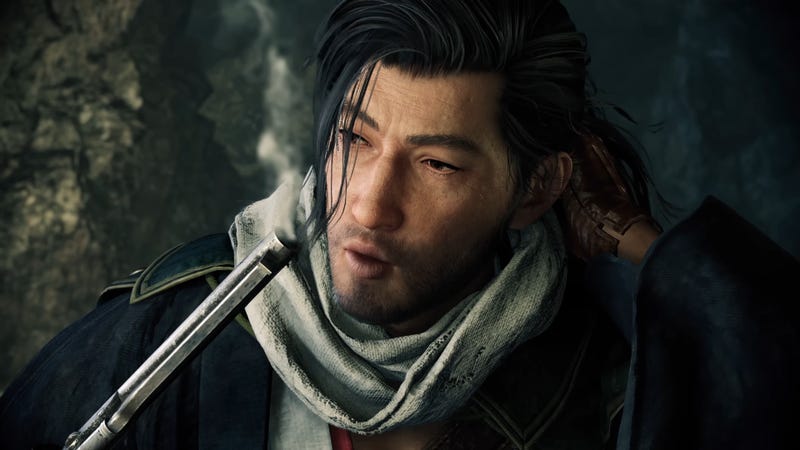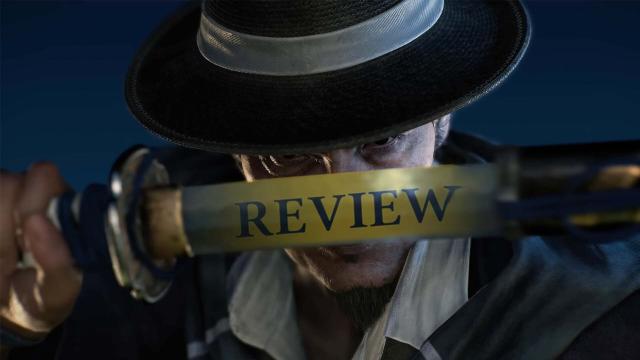Rise of the Ronin feels like a game that’s already one or two generations old. Developer Team Ninja has called it their “most ambitious” title to date, but that ambition is overshadowed by lackluster graphics, outdated design concepts, and performance issues that put the game more in line with the PS4 or even the PS3 libraries. Despite these shortcomings, Rise of the Ronin is still a commendable release for Team Ninja. It takes everything the studio does best and melds it with ideas from other games to create something that’s intriguing, albeit unoriginal.
Rise of the Ronin takes place during the Bakumatsu period, a time in Japan’s history that marked the end of the Tokugawa Shogunate and the beginning of the country’s opening to international trade. Your character, a nameless ronin whom you customize with some extensive options, finds themself separated from their “Blade Twin” (an unofficial sibling of sorts) and in the middle of a hate triangle between the anti-Shogunate faction, foreign settlers, and the pro-Shogunate forces. There’s plenty of political intrigue here, as the warring camps jockey for power to establish a new Japan during a period of turmoil and upheaval. Anyone familiar with the country’s history can probably surmise how the events of Rise of the Ronin play out, but Team Ninja’s interpretation of this pivotal period in 19th-century Japan is compelling all the same.
A familiar yet interesting history lesson
The driving force behind any story is its characters and writing. Rise of the Ronin handles both of these exceptionally. While occasionally heavy-handed with its exposition, both named and nameless characters have impressive depth to them. They’ll remember your previous actions, often hesitating to cooperate with you if you’ve engaged in criminal activity such as cutting down regular townsfolk. They’ll question your motives if they discover you might’ve been working with the opposing faction. Hell, they’ll even let loose on each other, frequently poking fun at their besties and enemies alike. This believable and rich characterization breathes life into historical figures, such as the modernization advocate Ryoma Sakamoto and the reformist intellectual Shoin Yoshida, who could come off as dusty relics in less capable hands.
The bummer, then, is that the story’s delivery is sometimes boring at best and incongruous at worst. Despite a cast of captivating characters who have remarkable rapport thanks to the game’s excellent writing, Rise of the Ronin’s narrative is still primarily doled out through people standing around like action figures. Serious shit is going on, but yet, folks loiter during dialogue sequences as if a war wasn’t brewing. It doesn’t even matter what’s happening, either.

During one cutscene, after I cooked an anti-Shogunate samurai in a sparring match, he faced me with his back straight, arms crossed, and eyes unblinking while coughing up a lung. The animation was completely at odds with what was happening. The same thing occurred a little later. Immediately after an assassination attempt on a pro-Shogunate official, my ally was panting like a dog while still standing up straight, as if we were waiting for coffee. These kinds of mismatches break the immersion during some of the game’s biggest moments, particularly since the narrative’s events are so dark and gritty.
Still, Rise of the Ronin had me hooked. I kept wanting to know what would happen next. The drama, the gossip, the occasional comedy, the love, the death, the pain—it’s a little bit of everything in a pot that simmers into a delicious, narratively rich campaign. And it’s bolstered by a captivating world that, while filled with the typical open-world busywork, has plenty of stunning vistas and emergent gameplay encounters that make use of its many varied RPG systems.
Dark Ghost of the Far Ronin Creed
It’s easy to look at Rise of the Ronin and immediately compare it to the other PlayStation 5 samurai ‘em up, Sucker Punch Productions’ Ghost of Tsushima. While the two games are artistically and thematically alike, Team Ninja’s latest is more of an amalgam of several other games. It’s a little bit Assassin’s Creed, a little bit Dark Souls, a little bit Far Cry, and a little bit Ghost of Tsushima all wrapped up into one package. It’s not a bad thing. In fact, anyone who enjoys Team Ninja’s previous games will likely fall in love with what Rise of the Ronin is attempting to achieve. It proudly wears its influences on its sleeves. At the same time, it takes many of the studio’s best elements, from combat mechanics to environmental design, and combines them into a sort of “Greatest Hits” album. For instance, the studio’s penchant for linear stages is very apparent in Rise of the Ronin, despite the game opting for an open-world structure. During certain missions, you’ll be funneled from combat area to combat area á la Ninja Gaiden, the Nioh games, or Wo Long: Fallen Dynasty. There’s some interlocking bits here and there, with paths twisting and folding into each other, but they do lack the intricacy of Team Ninja’s previous games.
But outside of these linear stages, the open world is memorable and vast. The adventure spans three huge cities—Edo (modern-day Tokyo), Kyoto, and Yokohama—each of them peppered with beautiful pagodas, mountainous terrain, and small villages. Some, like the port city of Yokohama, have more advanced technology than others because its seaside access allowed foreigners to dock and trade goods. Each city has its own distinct identity, which is great because most of what you’ll do in them is pretty repetitive, most often a riff on going to some place and murdering some person.
I’m not joking. Almost every action in Rise of the Ronin results in death. Asked to patch things up between former comrades? You gotta kill some bandits harassing one of them first. Dropping by one of the Pleasure District halls to flirt with a geisha? You gotta kill some ruffians blocking the doors to the pagoda first. Trying to visit the training dojo to sharpen your skills? You gotta kill some ronin who’ve set up camp there first. Even major story bits, which initially seem to allow for a non-violent solution, inevitably end in violence.
This design choice feels at odds with Rise of the Ronin’s dialogue options, many of which will impact your relationships with the people you’ll meet. Still, there are a handful of choices that have that can change how some situations play out. (Spare this person and they may join you in a war later on. Kill that person and you may very well have doomed the whole of Japan.) But these instances of meaningful decision-making are few and far between, and other than maybe three or four moments, the result is always the same: someone’s dead. I’m not averse to death. I love killing people (in Rise of the Ronin). I just wish the game lived up to its lofty goals when it comes to player agency and freedom.
A modern game stuck in the past
Thankfully, the combat is the best it’s ever been in a Team Ninja title. If you were intimidated by the systems in the Nioh franchise or Wo Long: Fallen Dynasty, then Rise of the Ronin is more approachable than those mechanically complex games. There isn’t a huge swath of attacks or customizable movelists. Stance changing, which appeared in the Nioh series, returns here, but it plays out in a more rock-paper-scissors kind of way, similar to Ghost of Tsushima. It’s an easy-to-understand system that also provides depth, as each weapon type has a multitude of available stances for you to unlock and master. The swordplay is satisfyingly crunchy—the clang of metal clashing together, the swipe of a sharp blade slicing through supple flesh, the crack of bones as you cut them at the joint (yes, there is dismemberment, and it rules) all feels hella good.
Rise of the Ronin’s combat does have Souls-y elements to it—insofar as enemies don’t fuck around and dying costs you a valuable upgrade resource called Karma—but it’s never cheap or unforgiving. Combos are easy to execute as they’re relegated to two buttons. Parries can deflect incoming damage and leave your enemy open to a one-hit finisher, but they’re not always necessary to win. Stealth is a viable, and often stronger, approach to combat situations. There’s even a fighting style based on Ninja Gaiden hot boy Ryu Hayabusa. It’s clear Team Ninja took the lessons it’s learned over the year and applied them here.

Unfortunately, Rise of the Ronin’s open-world design feels as old as dirt. This is a game that’s all about chasing map markers. You’ll start in, say, Yokohama, with just a handful of icons on your map: a cat to find, a treasure chest to open, a few main and side quests to finish, a bandit camp or two to wipe out. Your reward for completing these activities is unlocking more map markers to chase after. The formula repeats in the game’s other cities, and the open world slowly starts to blur together as you sprint from one end of the map to the other, checking off boxes on your to-do list. It really doesn’t help that many of these activities are copy-pasted from zone to zone. One time, some dude beckoned for help because “a fellow is running amok over there.” I followed him, but it was a trap, so I killed him and his homies, looted their bodies, and kept it moving. Maybe 10 or 20 minutes later, I got flagged down by a similar-looking dude with a similar-sounding request. Surprise! It was an ambush, but a slightly different one. Instead of him and his cronies, it was actually “a fellow running amok over there.” Me and this random dude tag-teamed the troublemaker. He thanked me, gave me some silver for my troubles, and I kept it moving. This activity happened again and again for about an hour straight during my playthrough. This isn’t the kind of interesting side content that keeps you wanting to engage with it, and it’s a big reason why Rise of the Ronin feels one or two generations old. The bland, banal side content hollows out the intriguing narrative it so desperately wants to tell. It’s bloat for bloat’s sake.
The visuals contribute to this dated feeling. Despite there being a Performance Mode that targets a more stable frame rate, Rise of the Ronin regularly chugged, especially while exploring densely populated areas. I’ve had about three hard crashes back to the PS5 dashboard while playing, two of which happened as I scrolled the in-game menus. I’ve gotten stuck in walls, lost all audio, and even had my DualSense’s haptic feedback killed (I literally had to buy a replacement controller). Closing and reopening the game fixed most of these issues, and there’s a day-one patch that should iron out the performance, but Rise of the Ronin isn’t as polished of an experience as it should be. It has its utterly gorge moments, don’t get me wrong, like when the sun breaks the top of a mountain or when the yellow-and-green reeds sway in the wind. But graphically, Rise of the Ronin has more in line with Game Republic’s 2006 action-adventure game Genji: Days of the Blade or Ninja Theory’s 2007 action-adventure game Heavenly Sword than Ghost of Tsushima.
And you know what? I don’t care. I don’t care that much of the open-world glut is flavorless and unsatisfying. I don’t care that the story is largely delivered through dolls whose bodies ignore the writing behind them. I don’t care that my decisions don’t always matter. I’m here for everything Rise of the Ronin is serving because I’m still having a great time with Team Ninja’s latest game. I’m enjoying the combat, which is approachable, deep, and varied. I’m enjoying the setting, which is inspired by IRL events I’ve studied for years. I’m enjoying the characters, all of whom are three-dimensional and memorable. (I’ve teared up a few times when some of my fave characters died.) Hell, I’m even enjoying the uninspired side content simply because I get to swing my sword. For better and worse, Rise of the Ronin is Team Ninja’s “Greatest Hits” RPG. There might be a dud or two in the tracklist, but on the whole, this record—I mean, game—bangs.

Leave a Reply